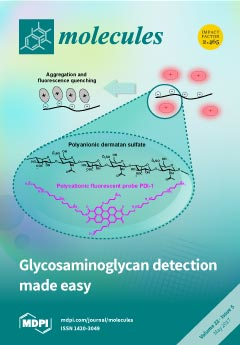Herein, a series of imidazo[4,5-
f][1,10] phenanthroline derivatives RPIP (PIP = imidazo [4,5-
f][1,10] phenanthroline, R = NO
2,
1; CF
3,
2; Cl,
3; OH,
4) have been synthesized in yields of 82.3–94.7% at
[...] Read more.
Herein, a series of imidazo[4,5-
f][1,10] phenanthroline derivatives RPIP (PIP = imidazo [4,5-
f][1,10] phenanthroline, R = NO
2,
1; CF
3,
2; Cl,
3; OH,
4) have been synthesized in yields of 82.3–94.7% at 100 °C under the irradiation of microwave. MTT assay has been utilized to evaluate the inhibitory activity (IC
50) of these compounds against the growth of various tumor cells, and the results revealed that these compounds, especially
1, exhibited excellent inhibitory activity against the growth of A549 cells with IC
50 of 15.03 μM. Moreover, it’s also confirmed that
1 can penetrate into the membrane of tumor cells and distribute in mitochondria when observed under microscopy, resulting apoptosis of tumor cells. The further studies showed that
1 can bind to
bcl-2 G-quadruplex DNA, which demonstrated by the increase of melting point of
bcl-2 G4 DNA in the presence of
1, as well as electronic titration and emission spectra. In a word, this kind of compound may develop as a potential apoptosis inducer in cancer chemotherapy via binding and stabilizing to the
bcl-2 G-quadruplex DNA.
Full article






